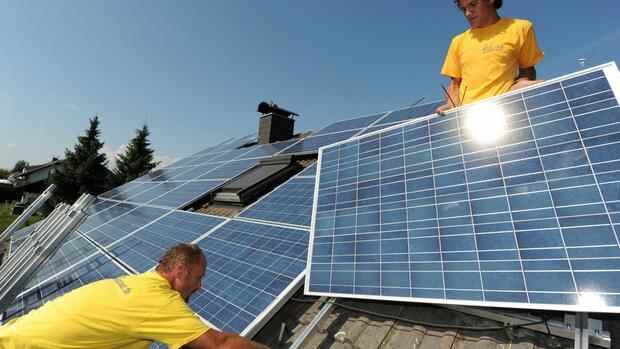Frankfurt The goal is ambitious: Around 80 percent of the energy generated in Germany should come from renewable sources by 2030. Solar power will play a key role in ensuring that the country can function in a largely climate-neutral manner in nine years.
“A solar system on every roof,” demanded the current Foreign Minister Annalena Baerbock (Greens) in the federal election campaign. A nationwide obligation for all residential buildings is not under discussion. However, the pressure on many house builders to expand photovoltaics is growing. According to the coalition agreement, solar roof cells should be mandatory for new commercial buildings and at least the rule for new private buildings.
Federal states such as Berlin or Baden-Württemberg have already decided to make solar roofs compulsory: Anyone who builds a house or renovates their own roof in one of the states from 2023 must install a solar system on the roof. But does such a system also pay off for homeowners?
Solar power from your own roof is not a financial sure-fire success. What sounds sensible for climate protection reasons can cost a lot of money – after all, regular costs for maintenance and insurance are added to the purchase and installation price of the solar system.
Top jobs of the day
Find the best jobs now and
be notified by email.
Energy experts from the electricity supplier Eon calculate that investment costs for a one- or two-family house range from around 9,000 to 20,000 euros; depending on the roof area and the output of the system. There are also running costs for maintenance, cleaning and insurance. Experts from the consulting company Co2online estimate that it costs 200 to 300 euros to have a photovoltaic system serviced for one- and two-family houses, for example.
This should be done about every four years to ensure that the solar system does not lose performance. Insurance cover is significantly more expensive: Solar roof systems should be covered against damage caused by storms, hail or fire either through residential building insurance or through external photovoltaic insurance. This costs between 60 and 250 euros per month. Good photovoltaic protection insures not only the solar cells but also the lightning protection device and the so-called data logger, which shows how much electricity the system is producing.
The investment is worth it in the long run – perhaps
Whether and when the investment in a solar system will pay for itself or even pay off can hardly be said in general terms. In principle, future house builders should think about a solar system now, recommends consumer advocate Thomas Engelke from the Federal Association of Consumer Advice Centers. After all, the parameters are then a little clearer – and it is easier to predict what the roof will cost and bring.
The electricity yield also plays a role in the calculation, which in turn depends heavily on the orientation of the roof: a roof that faces south produces significantly more solar power than one that faces north. The pitch of the roof and the location of the house also play a role.
Another question is whether homeowners mainly use the generated electricity themselves or feed a large part into the grid. Studies show: For homeowners who mainly consume the solar power themselves, a photovoltaic system pays for itself after ten to 14 years. “It’s still worth installing a solar system on the roof for your own use,” confirms energy expert Engelke. But for how long is questionable: “The conditions for this are becoming more difficult due to falling funding.”
>> Read here: For whom a solar system on the roof is worthwhile
The reason for this is the Renewable Energy Sources Act (EEG). Among other things, it provides that owners receive less money for the electricity that they feed into the grid and cannot consume themselves, the later they put the solar system into operation. An example: Anyone who had installed a solar roof system with an output of ten kilowatts in 2020 still received a feed-in tariff of 8.48 cents per kilowatt hour. Anyone who is only now installing solar cells on the roof, on the other hand, only gets paid 6.83 cents. It’s going downhill from year to year.
Promote more instead of obliging – lack of craftsmen as a risk
In 2020, the Fraunhofer Institute for Solar Energy Systems calculated that the expansion of solar energy would have to be accelerated to around 15 gigawatts per year. This is the only way to achieve the EU’s new climate targets. “According to our estimates, a solar obligation in new buildings should at best provide about one gigawatt of additional solar energy per year,” says Carsten Körnig, Managing Director of the German Solar Industry Association (BSW). An obligation should therefore not significantly advance the expansion of photovoltaics.
Instead, experts are hoping that the government will remove obstacles and expand subsidies for solar energy again. The federal government should readjust the EEG in particular and “make the construction of solar roofs attractive again as soon as possible,” demands Körnig.
Especially since there is already a high level of acceptance for solar power, especially on commercial sites. According to a survey by Eon, more than half of German entrepreneurs can imagine buying a solar system. Around a fifth of those surveyed already generate electricity using solar energy.
Should a solar obligation come without additional subsidies, it could end up doing more harm than good. “Without funding, builders would only implement the required minimum,” says Körnig.
The quality of the system may no longer play a role either. “Bottlenecks such as the lack of craftsmen could also lead to demand making solar systems more expensive as part of a duty,” fears consumer advocate Engelke. Either way, it pays off for homeowners to switch to solar power as quickly as possible if they are flirting with the idea.
More on this: Electricity from the balcony: These founders encourage tenants to have their own solar systems
